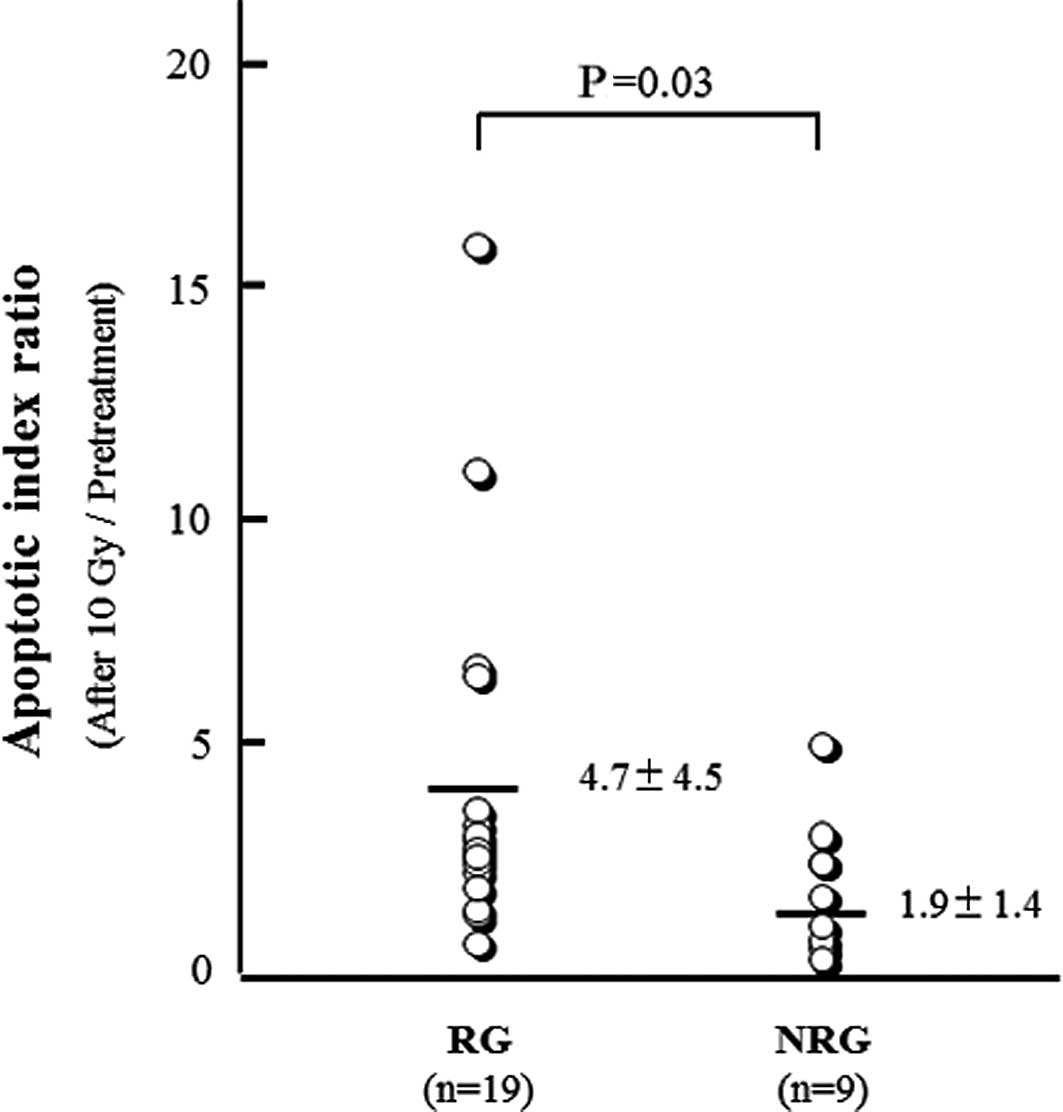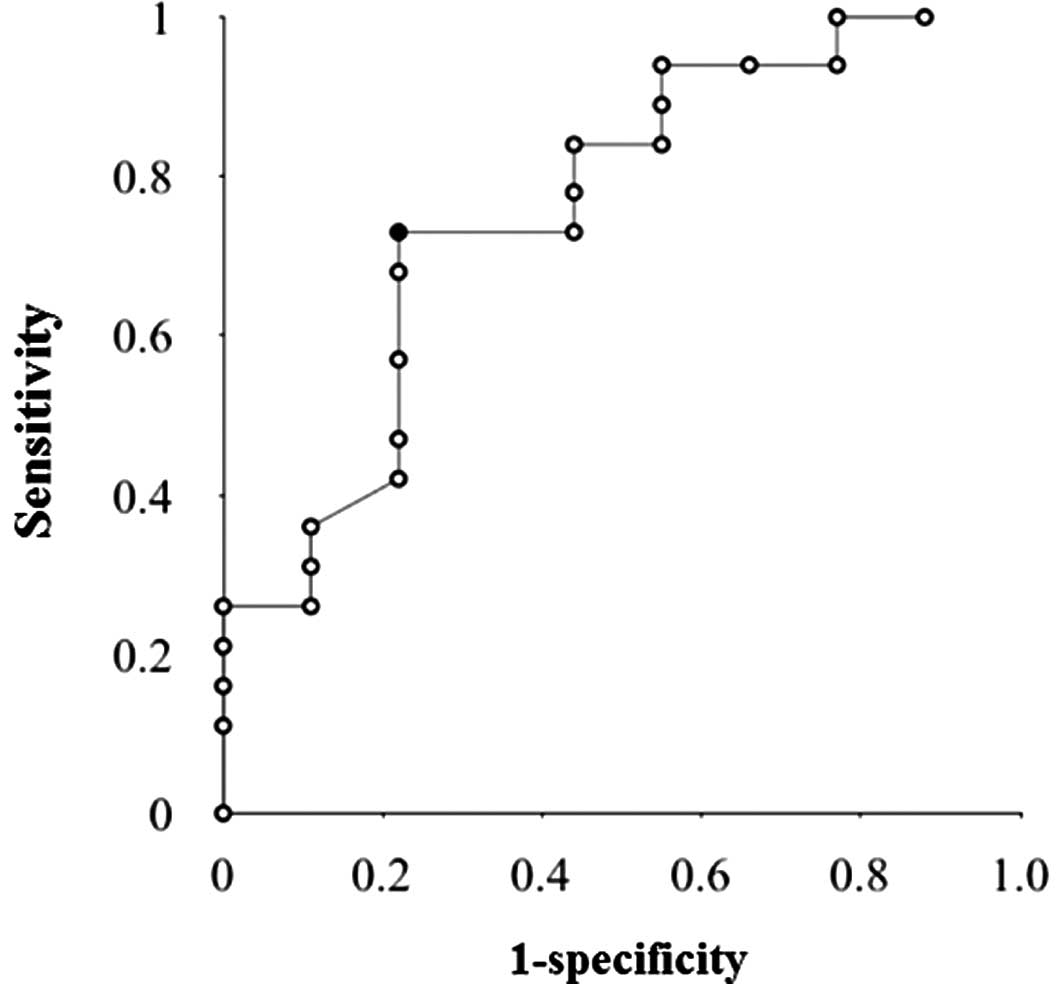|
1
|
Greer SE, Goodney PP, Sutton JE and
Birkmeyer JD: Neoadjuvant chemoradiotherapy for esophageal
carcinoma: A meta-analysis. Surgery. 137:172–177. 2005. View Article : Google Scholar : PubMed/NCBI
|
|
2
|
Fiorica F, Di Bona D, Schepis F, Licata A,
Shahied L, Venturi A, Falchi AM, Craxì A and Cammà C: Preoperative
chemoradiotherapy for oesophageal cancer: A systematic review and
meta-analysis. Gut. 53:925–930. 2004. View Article : Google Scholar : PubMed/NCBI
|
|
3
|
Urschel JD and Vasan H: A meta-analysis of
randomized controlled trials that compared neoadjuvant
chemoradiation and surgery to surgery alone for resectable
esophageal cancer. Am J Surg. 185:538–543. 2003. View Article : Google Scholar
|
|
4
|
Tepper J, Krasna MJ, Niedzwiecki D, Hollis
D, Reed CE, Goldberg R, Kiel K, Willett C, Sugarbaker D and Mayer
R: Phase III trial of trimodality therapy with cisplatin,
fluorouracil, radiotherapy, and surgery compared with surgery alone
for esophageal cancer: CALGB 9781. J Clin Oncol. 26:1086–1092.
2008. View Article : Google Scholar : PubMed/NCBI
|
|
5
|
Lv J, Cao XF, Zhu B, Ji L, Tao L and Wang
DD: Effect of neoadjuvant chemoradiotherapy on prognosis and
surgery for esophageal carcinoma. World J Gastroenterol.
15:4962–4968. 2009. View Article : Google Scholar : PubMed/NCBI
|
|
6
|
Theisen J, Krause B, Peschel C, Schmid R,
Geinitz H and Friess H: Early response evaluation and prediction in
neoadjuvant-treated patients with esophageal cancer. World J
Gastrointest Surg. 1:30–37. 2009. View Article : Google Scholar : PubMed/NCBI
|
|
7
|
Muro K, Ohtsu A, Boku N, Chin K, Oda Y,
Fujii T, Hosokawa K, Yoshida S and Hasebe T: Association of p53
protein expression with responses and survival of patients with
locally advanced esophageal carcinoma treated with
chemoradiotherapy. Jpn J Clin Oncol. 26:65–69. 1996. View Article : Google Scholar : PubMed/NCBI
|
|
8
|
Shimoyama S, Konishi T, Kawahara M, Aoki
F, Harada N, Shimizu S, Murakami T and Kaminishi M: Expression and
alteration of p53 and p21(waf1/cip1) influence the sensitivity of
chemoradiation therapy for esophageal cancer.
Hepatogastroenterology. 45:1497–1504. 1998.PubMed/NCBI
|
|
9
|
Kitamura K, Saeki H, Kawaguchi H, Araki K,
Ohno S, Kuwano H, Maehara Y and Sugimachi K: Immunohistochemical
status of the p53 protein and Ki-67 antigen using biopsied
specimens can predict a sensitivity to neoadjuvant therapy in
patients with esophageal cancer. Hepatogastroenterology.
47:419–423. 2000.PubMed/NCBI
|
|
10
|
Shimoji H, Miyazato H, Nakachi A,
Kuniyoshi S, Isa T, Shiraishi M, Muto Y and Toda T: Expression of
p53, bcl-2, and bax as predictors of response to radiotherapy in
esophageal cancer. Dis Esophagus. 13:185–190. 2000. View Article : Google Scholar : PubMed/NCBI
|
|
11
|
Jego G, Hazoumé A, Seigneuric R and
Garrido C: Targeting heat shock proteins in cancer. Cancer Lett. 13
November;2010.(E-pub ahead of print).
|
|
12
|
Gullo C, Au M, Feng G and Teoh G: The
biology of Ku and its potential oncogenic role in cancer. Biochim
Biophys Acta. 1765:223–234. 2006.PubMed/NCBI
|
|
13
|
Hefferin ML and Tomkinson AE: Mechanism of
DNA double-strand break repair by non-homologous end joining. DNA
Repair (Amst). 4:639–648. 2005. View Article : Google Scholar : PubMed/NCBI
|
|
14
|
Sohda M, Ishikawa H, Masuda N, Kato H,
Miyazaki T, Nakajima M, Fukuchi M, Manda R, Fukai Y, Sakurai H and
Kuwano H: Pretreatment evaluation of combined HIF-1alpha, p53 and
p21 expression is a useful and sensitive indicator of response to
radiation and chemotherapy in esophageal cancer. Int J Cancer.
110:838–844. 2004. View Article : Google Scholar : PubMed/NCBI
|
|
15
|
Sobin LH and Wittekind C: TNM
Classification of Malignant Tumours: Sixth edition. Wiley-Liss; New
York, NY: pp. 72–76. 2002
|
|
16
|
Therasse P, Arbuck SG, Eisenhauer EA,
Wanders J, Kaplan RS, Rubinstein L, Verweij J, Van Glabbeke M, van
Oosterom AT, Christian MC and Gwyther SG: New guidelines to
evaluate the response to treatment in solid tumors. J Natl Cancer
Inst. 92:205–216. 2000. View Article : Google Scholar : PubMed/NCBI
|
|
17
|
Japanese Society for Esophageal Diseases.
Guidelines for the clinical and pathologic studies on carcinoma of
the esophagus, ninth edition: Preface, general principles, part I.
Esophagus. 1:61–88. 2004.
|
|
18
|
Japan Esophageal Society. Japanese
Classification of Esophageal Cancer. 10th ed. Kanehara, Tokyo:
2007
|
|
19
|
Oka K, Suzuki Y and Nakano T: High growth
fraction at 9 grays of radiotherapy is associated with a good
prognosis for patients with cervical squamous cell carcinoma.
Cancer. 89:1526–1531. 2000. View Article : Google Scholar : PubMed/NCBI
|
|
20
|
Valente G, Orecchia R, Gandolfo S, Arnaudo
M, Ragona R, Kerim S and Palestro G: Can Ki67 immunostaining
predict response to radiotherapy in oral squamous cell carcinoma? J
Clin Pathol. 47:109–112. 1994. View Article : Google Scholar : PubMed/NCBI
|
|
21
|
Raju U, Ariga H, Koto M, Lu X, Pickett J,
Valdecanas D, Mason KA and Milas L: Improvement of esophageal
adenocarcinoma cell and xenograft responses to radiation by
targeting cyclin-dependent kinases. Radiother Oncol. 80:185–191.
2006. View Article : Google Scholar : PubMed/NCBI
|
|
22
|
Mitsuhashi N, Takahashi T, Sakurai H,
Nozaki M, Akimoto T, Hasegawa M, Saito Y, Matsumoto H, Higuchi K,
Maebayashi K and Niibe H: A radioresistant variant cell line,
NMT-1R, isolated from a radiosensitive rat yolk sac tumour cell
line, NMT-1: differences of early radiation-induced morphological
changes, especially apoptosis. Int J Radiat Biol. 69:329–336. 1996.
View Article : Google Scholar
|
|
23
|
Miyata H, Doki Y, Shiozaki H, Inoue M,
Yano M, Fujiwara Y, Yamamoto H, Nishioka K, Kishi K and Monden M:
CDC25B and p53 are independently implicated in radiation
sensitivity for human esophageal cancers. Clin Cancer Res.
6:4859–4865. 2000.PubMed/NCBI
|
|
24
|
Matsubara H, Kimura M, Sugaya M, Koide Y,
Gunji Y, Takegana K, Asano T, Ochiai T, Isono K, Sakiyama S and
Tagawa M: Expression of wild-type p53 gene confers increased
sensitivity to radiation and chemotherapeutic agents in human
esophageal carcinoma cells. Int J Oncol. 14:1081–1085.
1999.PubMed/NCBI
|
|
25
|
Ito T, Kaneko K, Makino R, Ito H, Konishi
K, Kurahashi T, Kitahara T and Mitamura K: Prognostic value of p53
mutations in patients with locally advanced esophageal carcinoma
treated with definitive chemoradiotherapy. J Gastroenterol.
36:303–311. 2001. View Article : Google Scholar : PubMed/NCBI
|
|
26
|
Sarbia M, Porschen R, Borchard F,
Horstmann O, Willers R and Gabbert HE: p53 protein expression and
prognosis in squamous cell carcinoma of the esophagus. Cancer.
74:2218–2223. 1994. View Article : Google Scholar : PubMed/NCBI
|

















